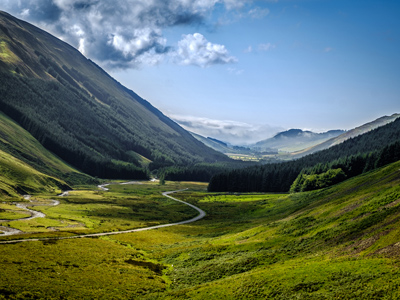During your physical geography studies in high school, you will learn about how different forces of nature shape the Earth's surface. One of the significant forces that has affected the British landscape is ice. You need to know how glacial erosion landforms have been created and to be able to give some examples of each.
During the last ice age, there were times that almost the whole of Britain was covered in glaciers and ice sheets. These advanced and retreated several times during the 120,000 years or so that the ice age lasted. With each advance, the ice eroded the landscape a little more, leaving traces that we can see today. In the lowland areas, this is not as evident as in the uplands where you can see many glacial erosion landforms.
The most obvious feature of glacial erosion is the classic U-shaped valley.
A glacier forms high in the hills or mountains and the ice slowly moves downhill under the influence of gravity. It will follow the line of least resistance, which is usually an existing V-shaped river valley. As it progresses, the interlocking spurs are eroded to form truncated spurs and the valley is straightened and deepened, changing the valley profile from being V-shaped to U-shaped. Where two glaciers meet and join, the combined weight and erosional power causes the valley to be deepened and widened even more. If one glacier is smaller, then you can be left with a hanging valley. This is a small U-shaped valley that can be seen joining the main valley high up in the side.
Where the bedrock is a little softer, the glacier can deepen the base of the valley a little more. This leaves a depression in the valley floor that can fill with water when the glacier has melted, leaving behind a ribbon lake. This can also happen where the glacier encounters harder rock lower down the valley, it erodes the valley floor less, leaving a slight rise. If this extends the whole width of the valley, it can dam a lake behind it. When a glacier melts, a huge amount of rock and water is released. This rushes out from underneath the glacier, carving a deep, narrow ravine.
A glacier starts where there is more winter snowfall than summer melting. Layers of snow build up in a depression on a hill or mountainside and gradually turn to ice. As this ice moves, it gouges out a more or less circular structure that is called a corrie, cwm or cirque. All three words describe the same type of feature. They are often overdeepened by the action of the ice and leave behind a small lake. Above the surface of the ice, freeze-thaw weathering creates pyramidal peaks and arêtes and breaks off the pieces of rock that give glaciers their erosional power.








